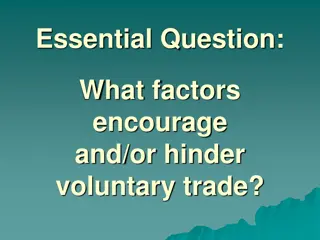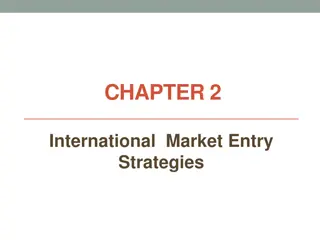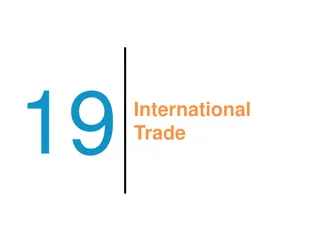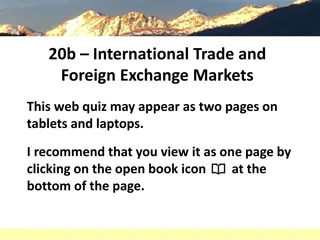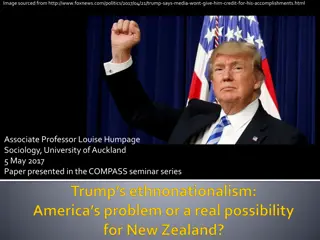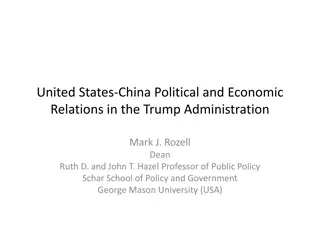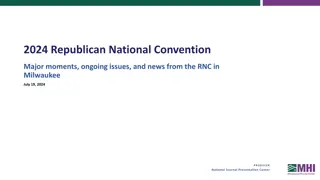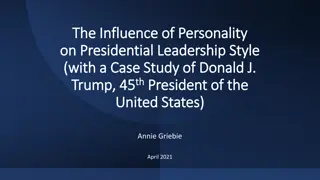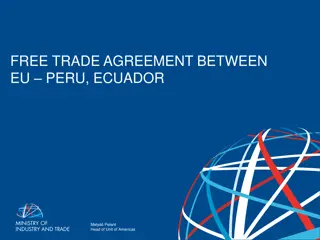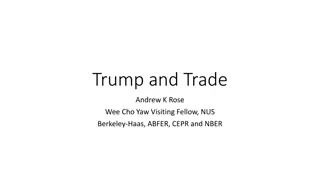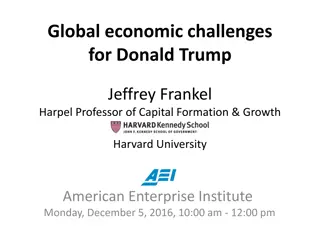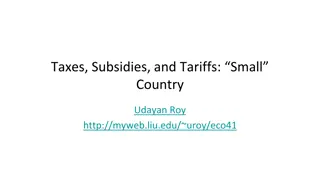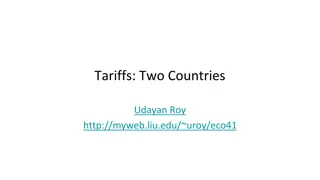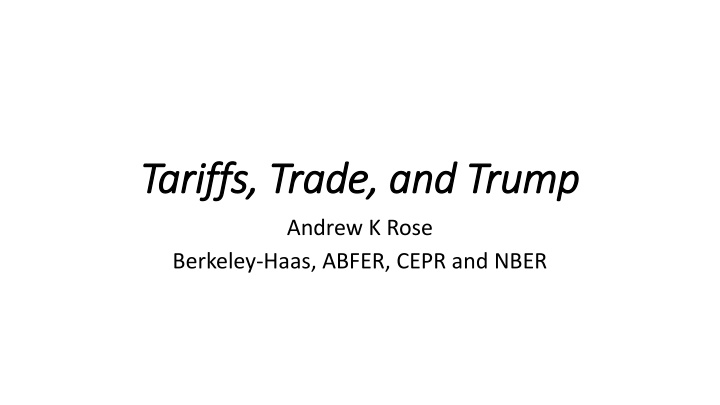
Tariffs, Trade, and Trump: Insights and Implications
Delve into the intricate dynamics of tariffs, trade policies, and the impact of the Trump administration on global commerce. Explore macroeconomic effects, soft power correlations, and key findings on productivity, inequality, and more. Uncover the gap in literature and stress on sensitivity analyses, supported by a robust methodology and compelling macro data insights.
Download Presentation

Please find below an Image/Link to download the presentation.
The content on the website is provided AS IS for your information and personal use only. It may not be sold, licensed, or shared on other websites without obtaining consent from the author. If you encounter any issues during the download, it is possible that the publisher has removed the file from their server.
You are allowed to download the files provided on this website for personal or commercial use, subject to the condition that they are used lawfully. All files are the property of their respective owners.
The content on the website is provided AS IS for your information and personal use only. It may not be sold, licensed, or shared on other websites without obtaining consent from the author.
E N D
Presentation Transcript
Tariffs, Trade, and Trump Tariffs, Trade, and Trump Andrew K Rose Berkeley-Haas, ABFER, CEPR and NBER
Todays Agenda 1. New Research on Macroeconomic Tariff Effects 2. What Effect is Trump Himself Having on American Exports? New Research linking Soft Power to Trade Tariffs, Trade, and Trump: Andrew Rose 2
Joint work with Furceri, Hannan and Ostry Key Question: What are the macro effects of tariffs? Output Productivity Unemployment Inequality Real exchange rate Trade balance Tariffs, Trade, and Trump: Andrew Rose 3
Gap in Literature Much work on protectionism theoretical Most empirical work microeconomic Sensible, given heterogeneity in protectionism, identification requiremen But even reduced form empirical work at macro level: missing! Tariffs, Trade, and Trump: Andrew Rose 4
Stress on Sensitivity Analysis Are Results Symmetric? o Tariffs rising/falling o Advanced economies/others o Good times/recessions o Conservative strategy: only medium term; ignore NTBs; domestic focus; ignore retaliation o All complemented with industry-level data Tariffs, Trade, and Trump: Andrew Rose 5
Methodology o Plain Vanilla: Jorda s (2005) LPM, to account for non- linearity without imposing dynamic restrictions o Large (unbalanced ) panel data covering 151 countries from 1996 to 2014 Tariffs, Trade, and Trump: Andrew Rose 6
Key Findings Tariff increases lead to: o Economically and statistically significant declines in output and productivity o Increases in inequality and unemployment o Exchange rate appreciation, and little effect on trade balance The effects of tariffs are larger: o When tariffs go up o In advanced economies o During economic expansions Tariffs, Trade, and Trump: Andrew Rose 7
Macro Data o Annual GDP, labor productivity (defined as the ratio of GDP to employment), unemployment rate, real effective exchange rates (period average, deflated by CPI) and trade balance (period average, deflated by GDP): IMF WEO and World Bank WDI o Gini coefficient from the Standardized World Income Inequality Database (SWIID) Tariffs, Trade, and Trump: Andrew Rose 8
Tariff Data o Based on trade tariff rate data at the product level. The main sources are the World Integrated Trade Solution (WITS) and World Development Indicators (WDI); other data sources include: the World Trade Organization (WTO); the General Agreement on Tariffs and Trade (GATT); and the Brussels Customs Union database (BTN) We aggregate product-level tariff data by calculating weighted averages, with weights given by the export share of each product, measured as fractions of value o Tariffs, Trade, and Trump: Andrew Rose 9
LPM (Jorda) Methodology yi,t+k - yi,t-1= i + t+ Ti,t + Xi,t + i,t yi,t+k is the outcome variable of interest (log of output, productivity, unemployment rate, Gini coefficient, log real exchange rate, or trade balance/GDP) for country i at time t+k, { i} country fixed effects (cross-country heterogeneity), { t} time fixed effects (global shocks), ??,? change in the tariff rate, is a vector of nuisance coefficients, Control variables: two lags of each of: a) changes in the dependent variable, b) the tariff, c) log output, d) the log of real exchange rates and d) the trade balance in percent of GDP DK standard errors; 90% confidence intervals Tariffs, Trade, and Trump: Andrew Rose 10
Tariff rises lead to declines in output and productivity Output (%) Productivity (%) 0.5 0.4 0.2 0 0.0 -0.2 -0.5 -0.4 -0.6 -1 -0.8 -1.5 -1.0 -1 0 1 2 3 4 5 -1 0 1 2 3 4 5 Note: The solid lines indicate the response of output (productivity) to one-standard deviation (about 3.6 percentage points) increase in the tariff rate; dotted lines correspond to 90 percent confidence bands. The x-axis denotes time. t=0 is the year of the reform. Estimates based on equation (1). Tariffs, Trade, and Trump: Andrew Rose 11 11
Increases in unemployment and inequality Unemployment (ppt) Inequality (ppt) 0.4 0.4 0.3 0.3 0.2 0.2 0.1 0 0.1 -0.1 0 -0.2 -0.3 -0.1 -1 0 1 2 3 4 5 -1 0 1 2 3 4 5 Tariffs, Trade, and Trump: Andrew Rose 12 12
RER appreciates; little effect on trade balance RER (%) Trade balance (ppt of GDP) 2.0 0.4 1.5 0.2 1.0 0.5 0 0.0 -0.2 -0.5 -1.0 -0.4 -1 0 1 2 3 4 5 -1 0 1 2 3 4 5 Tariffs, Trade, and Trump: Andrew Rose 13 13
Larger effects for tariff increases Productivity (%) tariff increases Output (%) tariff increases 2.0 5 0.0 0 -2.0 -4.0 -5 -1 0 1 2 3 4 5 -1 0 1 2 3 4 5 Output (%) tariff decreases Productivity (%) tariff decreases 2 2.0 0.0 0 -2.0 -2 -1 0 1 2 3 4 5 -1 0 1 2 3 4 5 14 Tariffs, Trade, and Trump: Andrew Rose 14
in advanced economies Productivity (%) AEs Output (%) AEs 5 2.0 0.0 0 -2.0 -5 -4.0 -1 0 1 2 3 4 5 -1 0 1 2 3 4 5 Output (%) EMDEs Productivity (%) EMDEs 1.0 1 0 0.0 -1 -1.0 -2 -1 0 1 2 3 4 5 -1 0 1 2 3 4 5 Tariffs, Trade, and Trump: Andrew Rose 15 15
and in expansions Productivity (%) Expansions Output (%) Expansions 5 2.0 0.0 0 -2.0 -5 -4.0 -1 0 1 2 3 4 5 -1 0 1 2 3 4 5 Output (%) Recessions Productivity (%) Recessions 2.0 4 2 0.0 0 -2.0 -2 -1 0 1 2 3 4 5 -1 0 1 2 3 4 5 Tariffs, Trade, and Trump: Andrew Rose 16 16
Robustness checksendogeneity Productivity (%) VAR Output (%) VAR 1.0 1.0 0.0 0.0 -1.0 -1.0 -1 0 1 2 3 4 5 -1 0 1 2 3 4 5 Output (%) IV Productivity (%) IV 1.0 1 0.0 0 -1.0 -1 -2.0 -2 -1 0 1 2 3 4 5 -1 0 1 2 3 4 5 Tariffs, Trade, and Trump: Andrew Rose 17 17
Summary and caveats Aversion of economics profession to the deadweight losses caused by protectionism seems well-founded o Tariffs lead to declines in output and productivity, increases in unemployment and inequality oEffects larger for tariff increases, for advanced economies and in expansions Caveats and Limitations o Reduced-form, purely empirical approach o Hard to isolate causal effects, though robustness checks mitigate this concern o Results may underestimate the effect in case of retaliation 18 Tariffs, Trade, and Trump: Andrew Rose 18
Todays Agenda 1. New Research on Macroeconomic Tariff Effects 2. What Effect is Trump Himself Having on American Exports? New Research linking Soft Power to Trade Tariffs, Trade, and Trump: Andrew Rose 19
Soft Power and Trade Does Trump s Leadership Style affect trade in and of itself? Hard power is the ability to coerce Grows out of country s military and economic might Soft Power (Nye) arises from attractiveness of country s culture, political ideals and policies the ability to attract, [since] attraction often leads to acquiescence soft power uses a different type of currency (not force, not money) to engender cooperation an attraction to shared values ... Does Trump s effect on US soft power affect trade? Tariffs, Trade, and Trump: Andrew Rose 20
How is Soft Power Measured? Gallup asks ( 1000) participants in (>150) countries: Do you approve or disapprove of the job performance of the leadership of China/Germany/Russia/UK/USA A standard measure of soft power Alternatives exist (deliver similar results) BBC/GlobeScan asks people in (>40) countries about (17) other countries: Please tell me if you think each of the following are having a mainly positive or negative influence in the world? Pew Research asks people in (>60) countries about (27) other countries: Please tell me if you have a very favorable, somewhat favorable, somewhat unfavorable or very unfavorable opinion of _____? Tariffs, Trade, and Trump: Andrew Rose 21
Informally: Trump has Harmed US Soft Power Average Foreign Views about the United States Unweighted Means from up to 157 Countries |--------------- Obama ----------------| Approval |--------------- Obama ----------------| Disapproval |--------------- Obama ----------------| Net Fraction Approval 60 60 .3 50 50 .2 40 40 .1 30 30 0 -.1 20 20 2006 2012 2017 2006 2012 2017 2006 2012 2017 Gallup: Do you approve or disapprove of the job performance of the leadership of the United States? Tariffs, Trade, and Trump: Andrew Rose 22
Still, a Range of Views Across Countries Foreign Views about American Leadership Box Plots of Surveys from up to 157 Countries Approve Disapprove Net Fraction Approval 100 100 |------------ Obama ----------------| |------------ Obama ----------------| |------------ Obama ----------------| 1 80 80 .5 60 60 0 40 40 -.5 20 20 -1 0 0 '06'07'08'09'10'11'12'13'14'15'16'17 '06'07'08'09'10'11'12'13'14'15'16'17 '06'07'08'09'10'11'12'13'14'15'16'17 Gallup: Do you approve or disapprove of the job performance of the leadership of the United States? Tariffs, Trade, and Trump: Andrew Rose 23
Histograms of Gallup Net Approval Foreign Views about the Leadership of Four Exporters Histograms of net fraction approval, up to 157 countries China, 2006 Germany, 2006 Russia, 2006 USA, 2006 2 2 2 2 1 1 1 1 0 0 0 0 -1 -.5 0 .5 1 -1 -.5 0 .5 1 -1 -.5 0 .5 1 -1 -.5 0 .5 1 China, 2012 Germany, 2012 Russia, 2012 USA, 2012 2 2 2 2 1 1 1 1 0 0 0 0 -1 -.5 0 .5 1 -1 -.5 0 .5 1 -1 -.5 0 .5 1 -1 -.5 0 .5 1 China, 2017 Germany, 2017 Russia, 2017 USA, 2017 2 2 2 2 1 1 1 1 0 0 0 0 -1 -.5 0 .5 1 -1 -.5 0 .5 1 -1 -.5 0 .5 1 -1 -.5 0 .5 1 Gallup: Do you approve or disapprove of the job performance of the leadership of ____? Tariffs, Trade, and Trump: Andrew Rose 24
Heterogeneity Critical Cross-country variation allows panel estimation Time-Series variation allows within estimation (fixed effects) Note that Trump about as popular as Bush So data within standard range of variation Tariffs, Trade, and Trump: Andrew Rose 25
Importers of US Goods Preferred Obama Views of American and German Leadership Obama vs. Trump; 157 countries, symbol area proportional to exports Foreign Views of US Foreign Views of US Approve Disapprove 100 100 Average 2009-16 Average 2009-16 25 50 75 25 50 75 0 0 0 25 50 2017 75 100 0 25 50 2017 75 100 Foreign Views of Germany Foreign Views of Germany Approve Disapprove 100 100 Average 2009-16 Average 2009-16 25 50 75 25 50 75 0 0 0 25 50 2017 75 100 0 25 50 2017 75 100 Gallup: Do you approve or disapprove of the job performance of the leadership of US/Germany? Tariffs, Trade, and Trump: Andrew Rose 26
Contrast China and Russia: Lined up on 45 Views of Chinese and Russian Leadership Obama vs. Trump; 157 countries, symbol area proportional to exports Foreign Views of China Foreign Views of China Approve Disapprove 100 100 Average 2009-16 Average 2009-16 25 50 75 25 50 75 0 0 0 25 50 2017 75 100 0 25 50 2017 75 100 Foreign Views of Russia Foreign Views of Russia Approve Disapprove 100 100 Average 2009-16 Average 2009-16 25 50 75 25 50 75 0 0 0 25 50 2017 75 100 0 25 50 2017 75 100 Gallup: Do you approve or disapprove of the job performance of the leadership of China/Russia? Tariffs, Trade, and Trump: Andrew Rose 27
Bush vs. Trump; roughly comparable Perceptions of Leadership under Republican Presidents Bush vs. Trump; 157 countries, symbol area proportional to exports Foreign Views of US Foreign Views of US Approve Disapprove 100 100 Average 2006-08 Average 2006-08 25 50 75 25 50 75 0 0 0 25 50 2017 75 100 0 25 50 2017 75 100 Foreign Views of Germany Foreign Views of Germany Approve Disapprove 100 100 Average 2006-08 Average 2006-08 25 50 75 25 50 75 0 0 0 25 50 2017 75 100 0 25 50 2017 75 100 Gallup: Do you approve or disapprove of the job performance of the leadership of US/Germany? Tariffs, Trade, and Trump: Andrew Rose 28
But Does Soft Power Actually Affect Exports? Need to control for other export determinants via Gravity Model One country (e.g., US) trades more with countries which are: Larger in economic mass (GDP) Closer Geographically: distance, common land border Culturally: share language, colonial heritage Politically: regional trade agreement Gravity: a (rare) example of an economic model that works well in both theory and practice Fits well; large and similar (across study) effects of income, distance Heritage of Tinbergen (and Newton) Tariffs, Trade, and Trump: Andrew Rose 29
Estimating Equation Least Squares with Dummy Variables (Head-Mayer LSDV): ln(Xijt) = SOFTPOWERijt + 1ln(Dij) + 2Langij + 3Contij + 4RTAijt + 5Colonyij + { it} + { jt} + ijt One-way trade flows a function of measures of distance (geography, language, policy, history) Fixed effects (exporter/importer x time) do most of the work, cover all monadic constant/time-varying determinants 55 Exporter-Year/1426 Importer-Year FE Tariffs, Trade, and Trump: Andrew Rose 30
Data Bilateral DoTS data from IMF 2006-17, for 5 exporters, 157 importers, 6,331 observations, LS estimation CIA World Factbook for country-specific variables (All available online at my website) Tariffs, Trade, and Trump: Andrew Rose 31
Soft Power Has a Big Effect! Log(Approval) .66** (.12) Log(Disapproval) -.35** (.10) Net Fraction Approval .91** (.20) -.83** (.09) .35* (.18) .79** (.30) .54** (.19) .83** (.02) 6,331 Log Distance Common Language Common Border Regional Trade Agreement -.77** (.09) .39* (.17) .76** (.29) .52** (.19) .81** (.20) 6,331 -.89** (.09) .38* (.18) .82** (.30) .60** (.20) .88** (.20) 6,331 Colonial Relationship Observations R2 .87 .87 .87 Tariffs, Trade, and Trump: Andrew Rose 32
Result is Robust 1. Different Measures of Soft Power 2. Different cuts of the data, variants of the functional form, 3. Different estimators; Instrumental variables Dyadic (pair-specific) fixed effects PPML to account for zeros in regressand, heterogeneity ... Tariffs, Trade, and Trump: Andrew Rose 33
Robustness: Different Measures of Soft Power Good Bad Net Observations Lag of Approval, Gallup .70** (.12) -.38** (.10) 1.02** (.20) 5,812 Current+1st+2nd Lags, ( 2 (1)), Gallup Log (Positive Influence), BBC .78** (27.8) -.41** (11.5) 1.08** (20.8) 4,166 .48** (.13) .77** (.22) -.30** (.10) 3,369 .62** (.22) 1,946 Log (Favorable Opinion),Pew .55** (.17) -.31* (.12) Tariffs, Trade, and Trump: Andrew Rose 34
Sensitivity Analysis Ln Approval Ln Disapp Net Approv Ln Approval Ln Disapp Net Approv Drop gravity covariates Sub Exp, Imp, Time FE 1.45** (.14) .41** (.07) -.78** (.13) -.23** (.06) 2.15** (.23) .64** (.14) Drop Industrial Exporters Drop Industrial Importers 1.53** (.31) .93** (.15) -.86** (.30) -.44** (.11) 2.54** (.69) 1.31** (.25) Add Dyadic FE .03 (.05) .76** (.14) .66** (.12) -.06 (.04 -.43** (.12) -.33** (.10) .20* (.08) 1.01** (.22) .99** (.21) Drop >|2.5 | residuals Conventional standard errors IV (BBC inf; 975 obs) .62** (.10) .66** (.05) .39** (.12) -.32** (.09) -.35** (.04) -.28* (.12) .79** (.17) .91** (.08) .57** (.20) Drop 2006-09 Drop 2014-17 2009 .58** (.15) .53** (.18) -.26* (.11) -.39* (.15) .90** (.26) .71* (.28) IV (Pew favo; 835 obs) IV (others appr, <20% export) .53** (.13) .59** (.06) -.20 (.14) .03 (.05) .55** (.21) .41** (.09) 2014 Drop United States .73** (.14) -.43** (.12) 1.04** (.24) IV (others appr, <10% export) .24** (.08) .07 (.07) .15 (.12) Tariffs, Trade, and Trump: Andrew Rose 35
PPML, with Dyadic FE added Ln Approval Ln Disapp Net Approv Ln Approval Ln Disapp Net Approv Default .052* (.022) -.024 (.022) .101** (.038) Drop 2006 .048* (.022) -.033 (.022) .109** (.037) Approval Level (not log), Gallup .0020** (.0007) -.0019** (.0007) n/a Drop 2017 .058** (.022) -.029 (.022) .116** (.039) Log (Influence), BBC .064** (.018) -.010 (.014) .077** (.029) Only industrial Exporters .070* (.029) -.058* (.023) .069* (.034) Log (Opinion),Pew .101** (.034) .002 (.027) .070 (.050) No industrial Importers .072* (.030) -.015 (.030) .153** (.053) Lag of Approval, Gallup .065** (.020) -.033 (.022) .131** (.036) Drop >|2.5 | residuals .034 (.022) -.018 (.021) .093** (.036) Current+1st+2nd Lags, ( 2 (1)), Gallup .104** (8.7) -.083* (4.0) .248** (15.6) Tariffs, Trade, and Trump: Andrew Rose 36
How Big is the Trump Effect on Exports? A 1 percentage point improvement in leadership approval raises exports by .1% Average net approval by foreigners of the American leadership fell from +16.6% in 2016 (Obama s final year in office) to -7.4% in 2017 (the first year of the Trump presidency) Swing of 24 percentage points in average net approval lowers American exports by (.24*.91*$1.45tn ) .22% or $3.3 billion Probably more because both Canada and Mexico (largest US importers) had >50% declines in net American leadership approval Long run effects bigger than short run effects Tariffs, Trade, and Trump: Andrew Rose 37



